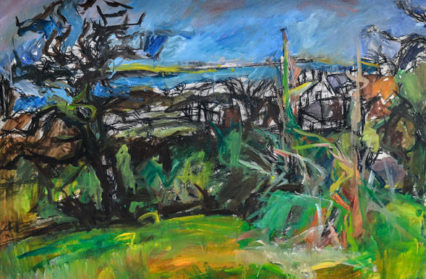As the official story has it, for a brief time Peter Prendergast was Wales’ finest landscape painter. His death came tragically early, at just 60 in 2007, four and half months after that of the pre-eminent Sir Kyffin Williams, and it seemed Wales had lost two of its greatest and most widely admired artists in too short-a-time. Ten years later, the Martin Tinney Gallery in Cardiff exhibits a career-spanning collection of Prendergast’s work, curated by his widow, and it is a display that asks some serious questions about the supposed hierarchy at Welsh art’s top table. Pendergast leaves behind a body of work that often outshines Williams’ in its ferocity, and has without doubt an intellectual honesty to it you might expect from a miner’s son.
Critics have been claiming since the late 1960’s that landscape painting was dead, that no great artist would in the modern age aim to recreate the specific appearance of a given landscape. If Cubism broke painting, it broke the landscape too. Landscape in that specific sense is all about analysis, about checking and checking again that scene beyond the canvas. There is an idea about landscape painting that is particularly nineteenth century. But in some hands this methodical attachment to a chiropractic need to click every part of the scene back into its rightful place can be elevated with a working understanding of all the lessons that twentieth century experimentalism has bestowed. To understand Prendergast’s work, however, is not to assign it to trends or schools, but rather to see it as a development in how our relationship to the land has changed. We no longer see the land, as the gentlemen painters of the nineteenth century did (Kyffin Williams certainly belongs in this lineage), but we have a relationship with it, as Prendergast did. To this extent Prendergast’s work is socio-political as well as philosophical. His benighted apparent suprerior tended to lean toward the replication of the landscape, if not always as meticulously as his forebears would have done; Prendergast was saying something quite different, in quite a different way. As John Berger wrote, “Today to hold a mirror up to nature is only to diminish the world.” There are no mirrors in Pendergast, only statements.
Prendergast’s work, when viewed across the spectrum of his career, digs into the landscape, tosses up trees and soil, whereas Williams blows like a cool breeze. He is punk rock to Williams’ comparatively modest chamber music. Prendergast focussed almost entirely on his beloved Snowdonia, and much of his earlier work is as overwhelmed as that landscape is overwhelming in reality. Many of these paintings – thirty in total, and dating from 1971 to 2005 – have not been exhibited before, and they act as a reaching out to the vast spread of his work in international collections. He has always been a popular artist, and it is easy to see why: his work is all about heart, all about driving the paint into the scene, turning the colour as if it is earth. At their most energetic they are depictions of man’s awe at nature.
Some works suggest fear – Prendergast’s work is not always comforting, not always heather and stream or slate and sky. “Damp Evening, Nant Ffrancon Valley”, for instance, is a masterful evocation of the contours of the valley, and speaks of something of the kinetic power of the forces that formed it. Prendergast has some of that power in him, but not his fear of it. It is a guttural reaction to gentility and all its affectations.
His early work is almost entirely without shape, this is an artist capturing how a scene makes him feel, not how it looks on a particular day. The legibility of these images is not only up for debate, but it is beside the point. Perhaps we can draw some conclusions about the artist and his outlook on life as form becomes more important as we go on. “Early Morning, Angelsey” is a masterwork of understanding the relationship between earth and human edifice, and Prendergast pulls together the metaphor that lies within the brushstrokes, that he brings human energy to a scene that has itself been crafted over millennia and is lit by the everlasting light. The painting itself is an island.
“Tal Y Bont View” (1992) sees Prendergast investigating the relationship between sky, water, stone and earth with uncommon regulation – it must have been a calm day – but linger on the blades of grass, then on the blue of the lake, and soon the image begins to seem more real than what it depicts. These works play a trick as old as time, that somehow passion is without philosophy, that it is childish and admirably loose, that it usurps great poise. Prendergast has no less poise than any of the great modern landscape painters you care to name, and one could even argue he has been unfairly overshadowed by the other Welshman. Ten years after his death, now seems as good a time as any to re-evaluate Prendergast’s work, and it is time to say that in Wales at least, he was second to none.



 Enjoyed this article? Support our writers directly by buying them a coffee and clicking this link.
Enjoyed this article? Support our writers directly by buying them a coffee and clicking this link.








